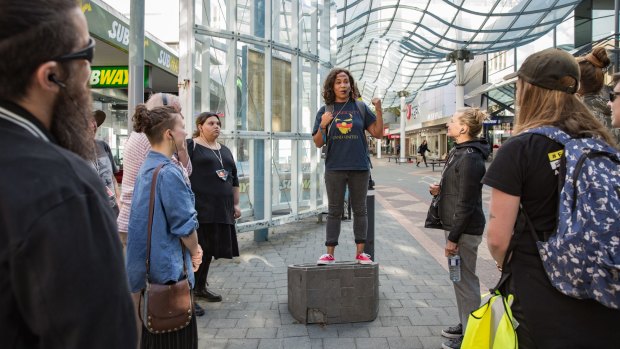This was published 1 year ago
Indigenous tours in Tasmania: New walking tour offers First Nations perspective on Hobart

Created and performed by Nunami Sculthorpe-Green, takara nipaluna (walking Hobart) launched in February 2022. Credit: Jillian Mundy
It's late morning in central nipaluna/Hobart when 30 of us gather around Nunami on the wide Elizabeth Street footpath. Cars roll past, buses wheeze, buildings block sky and I catch intermittent whiffs of exhaust and cigarette smoke. Then her voice comes through my earpiece: "I want you to imagine it in a different way". Together we all travel back to a mid-January day in 1832 during the Black War – a time of conflict here in lutruwita/Tasmania unfamiliar to even some locals on the tour.
Created and performed by Nunami Sculthorpe-Green, takara nipaluna (walking Hobart) launched in February 2022. This 90-minute experience highlights and honours the place, presence and stories of First Nations people in a city that has historically excluded them. At various points, along a 1.5 kilometre wheelchair accessible route through the CBD, this storyteller creates vivid scenes of barely known and rarely told events.
Nunami (NUN-ah-mee) is a palawa and Warlpiri woman with ancestral ties to lutruwita and the Tanami Desert area of the Northern Territory. She grew up in North Hobart and, on foot, knows the city like the back of her hand. Nunami is passionate about unfiltered Aboriginal stories and perspectives, also known as truth-telling.
I'd heard Nunami interviewed while she was developing takara nipaluna. "I'm obsessed with the idea that people think that you build a city and the people go," she'd told Hobart's ABC Radio. "But, no, we were watching them build the city, we're there as they build the city, the new settlers documented us coming in making demands and we continue to assert our voices within the city 200 years later. It's our city too."
On that day in 1832, a group of "proud, free and determined people" make their way through nipaluna/Hobart to negotiate with the governor. Most of them are of Oyster Bay and Big River nations and all have thousands of generations of connection to lutruwita. Britain invaded in 1803 and, as Nunami explains, after three decades "they have lost nearly everyone they know and love". Among them are leaders Tukalunginta and Muntipiliyata, the formidable warrior Eumarrah and renowned Nuenone woman Trukanini.
"I really encourage everyone to look each of them up," Nunami says and leads us towards the waterfront along the same route taken by those 40 members of the Aboriginal resistance.
The original peoples of lutruwita are palawa/pakana and Nunami was raised strong in that identity and culture here on Muwinina Country by what she describes as impressive role models within a supportive community. Nunami actively protests for the rights of Aboriginal and Torres Strait Islander peoples and recently hosted 'Young nipaluna' podcast. In 2014, she and pakana woman Tessa Atto repatriated the stolen remains of Nugarrika – a young woman of the northwest coast of lutruwita – from Berlin's Charite university.
Later, Nunami, says her journey towards developing the tour involved a gradual realisation of "what we had lost before we had gained". There were also huge lightbulb moments.
"To connect to our culture and connect to our people and our history," she'd assumed as a teenager, "I'd have to find a way to get far out of the city." Yet, into her 20s, Nunami realised she was occupying the same physical spaces as advocate and activist William Lanne, from northwest lutruwita, and treading the same street that Trukanini walked her dogs. "I'm literally walking there every day like, oh my god, I'm following our Old People's footsteps right now!"
Over time, Nunami recognised her right and responsibility to tell stories on behalf of her Old People. What cemented things was learning about what has become her tour's main story: "that march down Elizabeth Street – how powerful". In the end, she tells me, "I made [takara nipaluna] because I really wanted to and I really needed to".
Although Nunami is often asked where her information comes from she never leads with her history degree. "I actually don't believe you need Western institutions to validate your knowledge … We know what we are. We know who we are. We know so much about our place and our culture."
takara nipaluna joins the growing number of First Nations owned and operated business ventures across lutruwita dedicated to expressing and sharing culture such as Blackspace Creative, palawa kipli and wukalina Walk. "Our culture is strong and coming back stronger. Every year our echoes become louder. I love this city and I'm excited for the city to love us eventually."
THE DETAILS
FLY
Qantas flies to Hobart from Sydney and Melbourne. See qantas.com
TOUR
The 90-minute walking tour costs $50 a person, including the use of a headset. See blackledtours.com
STAY
Centrally located Alabama Hotel is independently owned by young Tasmanians. This retro space has a cute bar, comfy lounge, verandah and shared bathrooms. From $100 a room. See alabamahobart.com.au
Sign up for the Traveller Deals newsletter
Get exclusive travel deals delivered straight to your inbox. Sign up now.